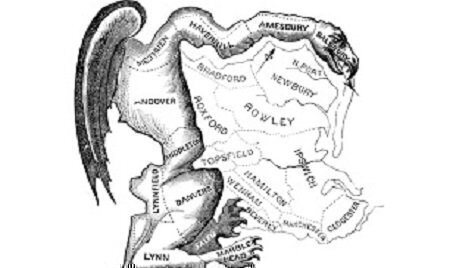The Supreme Court on Monday stepped, somewhat hesitantly, into the long-standing constitutional controversy over partisan gerrymandering, accepting a major test case for review but giving itself several ways to avoid deciding it.
 At issue is the question of whether the process of drawing new election district boundaries is unconstitutional if one political party specifically creates maps giving its own candidates a distinct advantage in getting elected, directly limiting the other party’s chances at the polls.
At issue is the question of whether the process of drawing new election district boundaries is unconstitutional if one political party specifically creates maps giving its own candidates a distinct advantage in getting elected, directly limiting the other party’s chances at the polls.
It is a political act that is as old as the American Republic, drawing its name as a “gerrymander” from a member of the Founding generation, Massachusetts Governor Elbridge Gerry, for his infamous state senate districting map so misshapen that it resembled an awkward salamander.
In its modern form, it is sometimes blamed for the deep partisan polarization of Congress and other legislative bodies, because modern computer science and detailed census data makes it so much easier for those in charge of drawing new maps to place individual voters into districts to make them decidedly Republican or Democratic so as to achieve unequal electoral power.
Sometimes, modern politicians openly admit that they have create redistricting plans that favor their party, because such gerrymandering has never been ruled unconstitutional by the Supreme Court so those politicians have no reluctance to set their partisan goals and achieve them.
A few times in the past, the court has taken on test cases on partisan gerrymandering, but it has refused, each time, to decide them after concluding that it could not come up with a workable constitutional formula on when partisanship had gone too far in a given redistricting process. At the same time, it also has never said it would refuse to take up the issue again.
In two orders on Monday, the Justices agreed to hear – though not necessarily decide – a high-profile case from Wisconsin, and then almost an hour later announced that it was blocking, by a 5-to-4 vote, a lower federal court ruling that had struck down the specific redistricting maps for the state’s general assembly.
Those maps, drawn mainly in secret by Republican lawmakers, had achieved one of the clearest cases in modern political history of achieving a lasting advantage for Republican candidates, even though the state’s voters are about evenly divided in their affiliation with the two major parties. The maps have been used in actual elections, and got the results that the mapmakers had intended.
With the separate order that split the court closely on Monday, the state legislature will now be spared the duty of working out a new map of election district for use in upcoming elections. The case will not come up in a hearing before the Justices until their next term, starting in October.
In striking down that plan, the lower court had concluded that it was developed in a way that the Republicans would continue to win the most seats in the assembly until there is a new census and the drawing of new maps. The lower court did devise a constitutional formula for judging when a partisan gerrymander did go too far.
That formula is being challenged in an appeal by state Republican leaders. They argue that the formula is not workable and that there is no way to devise one that will work in actual practice.
Although the court did not explain its willingness to schedule a hearing at the same time that it voted to block the lower court ruling in the meantime, its actions on Monday were not favorable to the challengers of the Wisconsin plan.
One of the factors that the court considers in putting a lower court ruling on hold is whether there is a fairly good chance that the lower court will be overturned, when a decision is made by the Justices. It takes five votes to issue such a postponement. On Monday, it was clear that these Justices favored that action, although the order did not name them explicitly; Chief Justice John G. Roberts, Jr., and Justices Samuel A. Alito, Jr., Neil M. Gorsuch, Anthony M. Kennedy, and Clarence Thomas.
The dissenters, who would have allowed the lower court ruling to go into effect were Justices
Stephen G. Breyer, Ruth Bader Ginsburg, Elena Kagan and Sonia Sotomayor.
In postponing until its hearing the issue of whether the court actually has jurisdiction to make a final decision for or against the partisan claim, the Justices did not say what that procedural hurdle might be.
Among the possibilities is that the question of whether a partisan gerrymander lawsuit can even be filed is a question of whether the issue is “justiciable” – that is, capable of being decided by a court. A non-justiciable dispute is beyond court authority.
There also are questions, in this particular case, on whether a court may hear a challenge to a redistricting plan based upon a claim of partisan gerrymandering if the challenge is statewide, and not district-by-district, and on whether the state’s Republican leaders had been denied any chance to defend their plan under the formula that the lower court had only disclosed in announcing its final decision. Whether those are questions of “jurisdiction” is unclear.
Legendary journalist Lyle Denniston is Constitution Daily’s Supreme Court correspondent. Denniston has written for us as a contributor since June 2011 and has covered the Supreme Court since 1958. His work also appears on lyldenlawnews.com.






